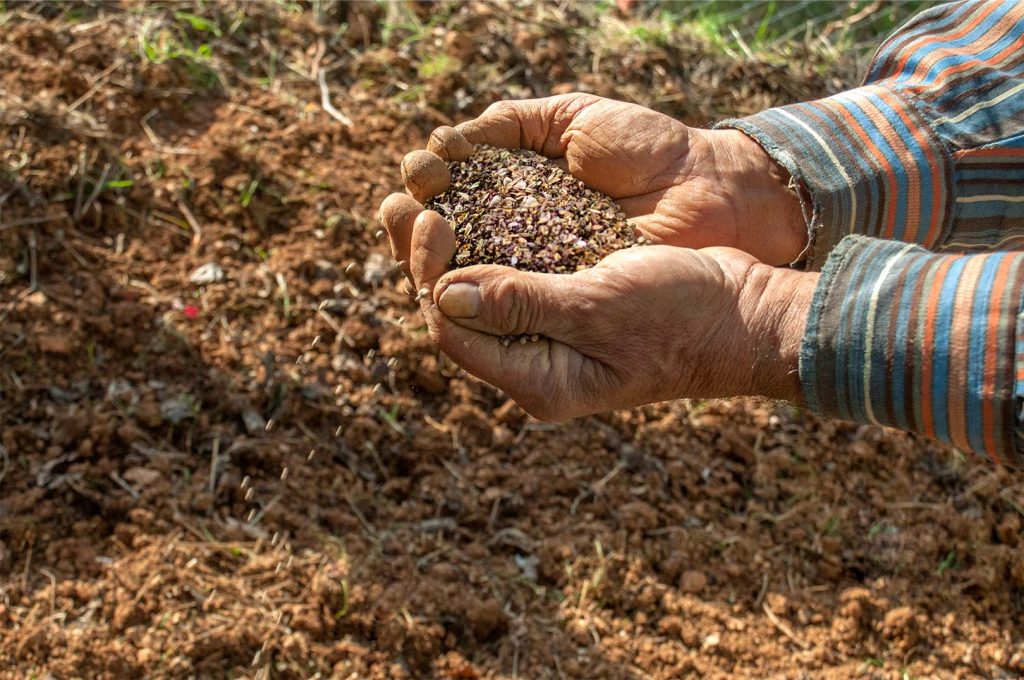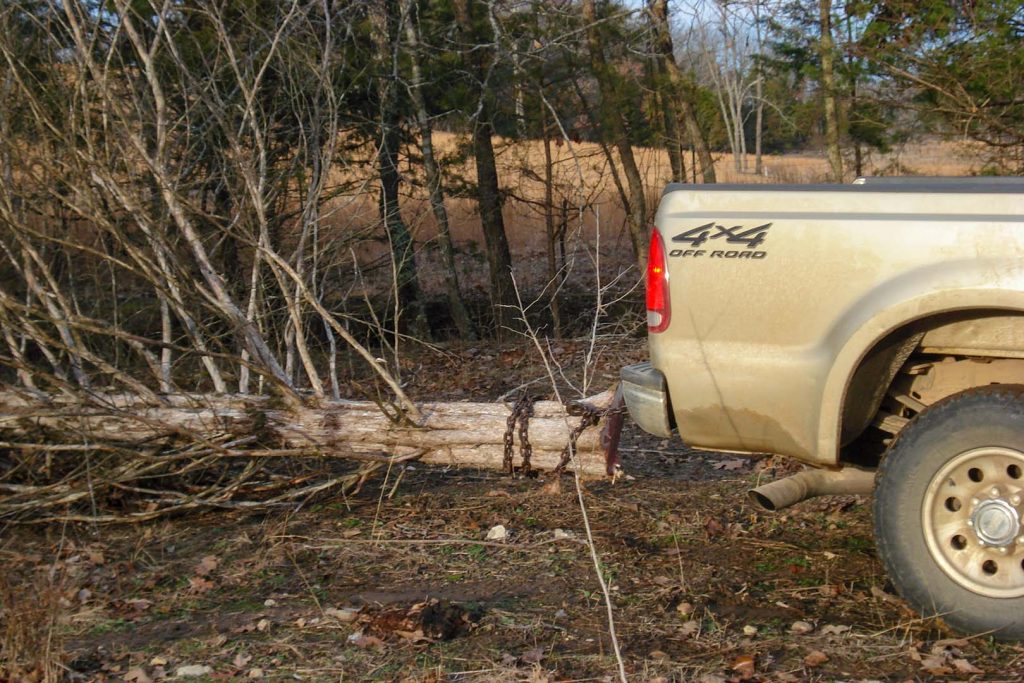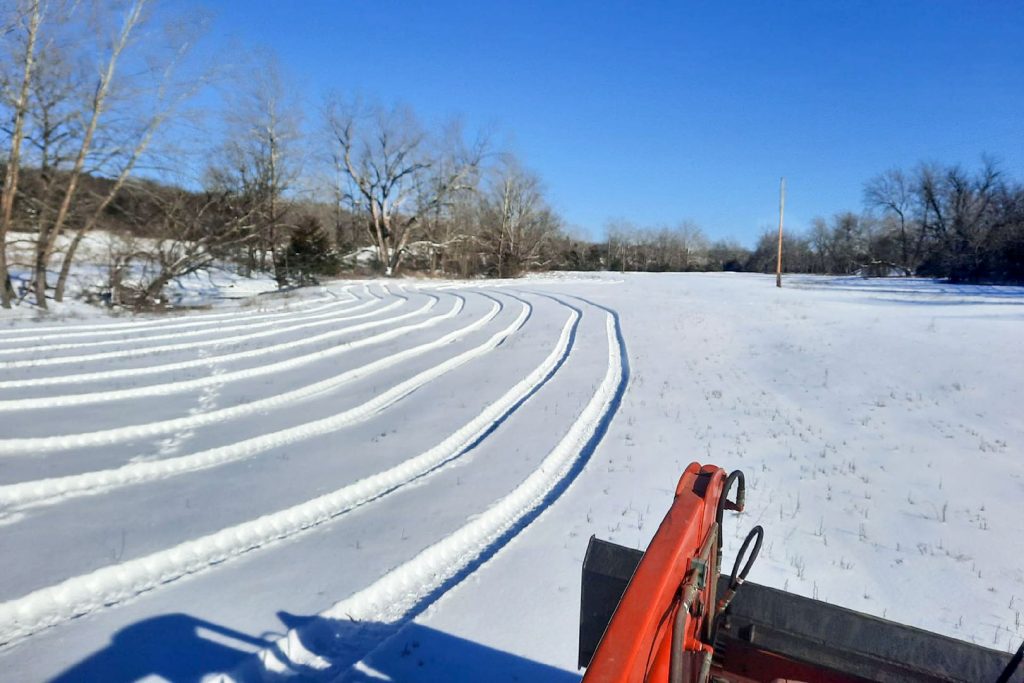
Seedbed Preparation by Dragging Guide
Table of Contents
Check out these answers and tips from Hamilton Native Outpost’s CEO and production manager, Colt Hamilton, about one of his favorite techniques to use when broadcasting seed. He terms this action “dragging” for the very literal reason that he is dragging something across the field to improve the seedbed and/or seed-to-soil contact.
Why drag a field?
The primary goal of dragging is to improve seed-to-soil contact when broadcasting seed. This is especially important when there is excessive thatch (dead plant material) on top of the soil or when there is recently killed sod that needs to be broken up a bit before planting. Dragging also makes it easier to see where the seed has been applied and the seeds won’t be as visible to the birds.
What exactly is a drag and where do I get one?
There are basically two parts needed to drag a field: Something pulling, such as a truck or tractor, and something to drag around.
The item being dragged can be made for that purpose, such as a chain drag or some type of harrow (note that some harrows give too much soil disturbance to use after planting), or it can be something repurposed such as old mattress springs. Or go with our personal favorite: Cut down an unwanted tree with a fairly stiff structure, such as a cedar or blackjack oak, and drag it.

When is it a good idea to drag?
Dragging after broadcast seeding helps get the seed into contact with the soil. We generally operate by the motto, “If in doubt, drag it.” However, in these situations, we consider it necessary:
Excessive thatch
Seed needs to be in contact with the soil to germinate. In other words, seed should not rest on top of an old dead leaf or be left suspended above the soil. Dragging is a very useful tool in situations where excessive thatch is present on top the soil. Dragging helps the smaller, more dense seeds sift down through the thatch to the ground to achieve seed-to-soil contact. Dragging can also incorporate a small amount of the thatch into the soil.
Lastly, dragging fluffs up leaves and some, such as large, flat, sturdy tree leaves, will blow away. In extreme cases where thatch is quite thick, it can be beneficial to drag before seeding as well as following seeding, but in cases where it is not so extreme, one or more draggings after seeding will usually suffice.
When near or past a seeding deadline
There are deadlines for planting—some seeds need to be planted during winter and some can be planted on into the spring. However, when the seeds being planted are near or past a deadline, dragging results in quick seed-to-soil contact rather than waiting for the natural elements such as rain and wind. So, if you are against a deadline, make sure to drag after seeding. (Note that it is not advisable to plant after the deadline, but if you choose to do it, dragging is a sensible action.)
Recently killed pasture or sod
Dragging helps when planting into a very recently killed field because it breaks up this sod. In these situations, drag shortly before seeding as well as while seeding or shortly after.
Compacted soil
Some soils are quite compacted, especially in fields that have been hayed for a lot of years, overgrazed pastures, and some crop fields. If the soil has the feel of pavement underfoot rather than a somewhat spongy soil that has some give to it, dragging can be helpful. Drag before seeding with multiple passes to loosen the top part of the soil a bit so there will be better seed-to-soil contact following broadcast seeding.
Capped or crusted-over soil
If the soil has been bare (no significant thatch covering the soil) and it has rained while it has been bare, it is likely that the soil has formed a crust or has become capped. In this case, drag shortly before or after broadcasting the seed to break this crust and getting good seed-to-soil contact.
Birds
If there are a particularly large number of birds in the area to be planted, dragg after planting to decrease the visibility of the planted seeds.
Planting large seeds
If the seed(s) being planted are particularly large, they tend to get hung up above the soil more than their smaller counterparts. Dragging can help get them in contact with the soil.
Eastern Gamagrass is a dominant part of the planting
Eastern Gamagrass is unique among the native seeds in that it is best planted at deeper depths than most other species. A drill is usually the first choice to plant this seed, however, sometimes a drill is not readily available or not a good choice. In this case, we’ve used broadcast and techniques with success.
If it looks like broadcast and dragging is the best option for an Eastern Gamagrass planting, drag aggressively, keeping in mind that it’s okay for the Eastern Gamagrass seeds to be buried about an inch. Also, sow the seed well before the dormant seeding deadline, which for untreated/unstratified Eastern Gamagrass seed is February 15. With the extra time, freezing, thawing and the elements help the dragging to achieve better soil coverage on the seed.
To keep track of what’s been seeded
Dragging will create visible marks in the soil. So, if you’re worried about missing spots while broadcasting, a drag can be helpful. Don’t forget that a drag may be wider or narrower than the broadcast pattern.
For most native seeds, it is ideal to drive so that the first set of tire tracks and the second are the same distance apart as the tires are apart from one another on the truck or tractor. In other words, when there has been one pass down the field and one pass back, there should be 4 tire tracks all equally spaced apart.

The nitty gritty of how to drag
Dragging is not a complicated process, but a few pointers can help make quick work of the job. If the object that is to be dragged was made for that purpose, there is probably a premade method of attachment (such as a 3-point hitch). However, if it is an improvised drag such as a tree, you can use a log chain or tow rope to attach the drag to a truck, tractor, or fertilizer spreader. If using a tree, pick a tree species with a fairly stiff structure, such as a cedar or blackjack oak. Many tree species such as hickory and elm are too flimsy and don’t give the desired amount of disturbance.
Seeding and dragging can occur in the same trip across the field if the drag follows at a little distance so that the seed can fall out of the broadcast seeder before the drag gets to it. There is no perfect width of drag, but don’t be concerned if the drag is wider than the broadcast pattern. Make sure to drive as the broadcast pattern requires and this will give some amount of repeated dragging from the wider drag, which is often good.
Cautions when dragging
- Make sure the drag, especially some types of harrows, is not too aggressive. Keep in mind that most native seeds should only be covered about 1/8-inch deep. To ensure this is happening, check that some seed is visible on the soil surface after the dragging. If you are unsure about a drag’s aggressiveness, run a pass around the field BEFORE seeding to see what kind of effect is has on the soil.
- If the dragging causes the soil to become fluffy (your cowboy boot heels sink into the soil more than 1/4 inch), do not roll the site after seeding. Too much loose soil causes the roller to push a ridge of loose soil along before it potentially burying seed too deep. Note that if a field is dragged after broadcasting, using a roller is not necessary.
- After dragging, thatch should not cover more than about 50% of the soil. Excessive thatch acts like mulch on a garden and prevents seedlings from either germinating or reaching sunlight. On sites where the thatch is quite thick, try dragging the field once or more ahead of planting to see what effect this has, or use a controlled burn to remove some thatch.
- If the soil is very wet, dragging can cause compaction and/or smear the soil surface. If the soil is too wet, wait until the soil is drier to drag.
What if dragging doesn’t seem practical?
Even though dragging is a relatively easy technique, it is not always practical. Sometimes an area is too small to effectively use mechanical equipment. In this case, a broom rake can have the same effect. Other times, there is too much thatch for a drag to effectively combat. Under this condition, a controlled burn may be an excellent tool to use before seeding and dragging, or consider a seed drill to cut through the thatch.
Want to see it for yourself?
To see a cedar tree being used as a drag, join Colt Hamilton in the video Preparing Your Seed Bed: Seed-to-Soil Contact.